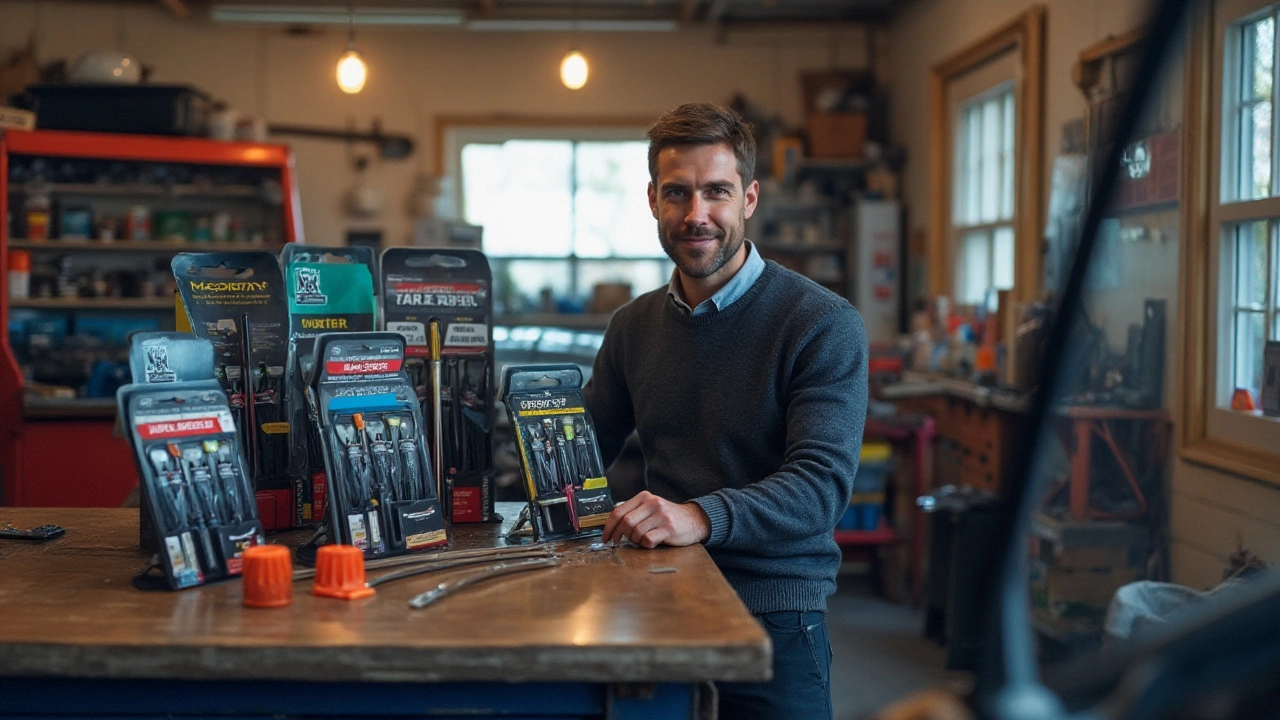Windscreen wipers are like the unsung heroes of driving. They might not have the roar of an engine or the allure of a sleek paint job, but their role is pivotal. I'm talking about those slender blades that clear away rain, sleet, or snow from your line of sight. If you've ever been caught in a sudden downpour or tried to navigate through a misty morning without them, you'd know exactly what I mean.
You may wonder, how often should those trusty blades be swapped out for fresh ones? Is it every six months? Once a year? Or perhaps when the squeaky noise becomes unbearable? Let's slide into the details and find out how to keep your wiper blades in peak condition, ensuring your drives remain as safe as they are smooth.
- Signs Your Wipers Need Replacing
- Factors Influencing Wiper Longevity
- How to Extend the Life of Wiper Blades
- Types of Wiper Blades and Their Benefits
- DIY Tips for Wiper Blade Replacement
Signs Your Wipers Need Replacing
Wiper blades, for all their simplicity, play a key role in car maintenance and safety. Yet, too often, they are overlooked until a heavy rainstorm hits. The first sign you need to replace your wiper blades is a poor performance in clearing the windshield. If you notice the blades leaving behind streaks or patches, it's a cue. This might mean the blades have worn out and can no longer maintain full contact with the windshield's surface. Over time, the rubber on the blades can degrade. Exposure to sun, rain, and snow can cause them to crack or harden, reducing their efficiency.
Another sign is the noise. Ideally, your windshield wipers should glide quietly across the glass. If you've started hearing them squeak or chatter, don't ignore it. This usually happens when the blades miss spots because they are deteriorating. It could also mean there's insufficient pressure being applied to the windshield. In extreme temperatures, both hot and cold, the wiper rubber becomes inflexible. This rigidity can lead to noise and inefficient wiping action.
Visual inspection is another way to assess your wipers' condition. This should be done every few months, especially if you live in areas with harsh climates. Look for cracks, tears, or missing chunks of rubber. If there's even the slightest bit of damage, replacing them is the safest bet. Additionally, pay heed to the metallic wiper frame. If it's bent or twisted due to manual manipulation or snow and ice, the blade won't fit snugly against the windshield. This misalignment often results in poor wiping performance.
"Replacing worn wipers with new ones not only ensures better visibility but also reduces the load on your washer and defroster systems," states the Automotive Maintenance Association.
Any lubrication issues or corrosion around your wiper mechanisms could hint at a nearing end. Keep an eye on the amount of fluid they are dispersing. If they don't spread the washer fluid evenly or, even worse, completely neglect some areas, you're in potential danger. It's also good practice to note the span of time since your last replacement. Ideally, switch out the wipers every six months to a year, depending on your usage and environment. However, frequent checks can help you stay ahead of potential issues and extend the life of your blades.
Poor Visibility and Its Risks
Driving is an activity that demands full attention. When visibility is compromised, so too is the safety of everyone in the car. Not replacing ineffective wiper blades quickly can seriously increase the chances of accidents, especially during downpours or snowfalls. Imagine being caught in a driving rain at night without clear visibility. Such situations can elevate stress and risk while driving tenfold.
When thinking about visibility hazards, note that sub-par wiper blades can obscure water droplets. This means your reaction times to road obstacles get slowed down. In particularly unfortunate scenarios, failing wipers might even cause the windshield to fog up. Lack of visibility on the road isn't merely inconvenient; it's dangerous. Hence, attending to these warning signs is not just about carelessness, but a commitment to safety on your drives.
Factors Influencing Wiper Longevity
The life of a set of wiper blades can be as unpredictable as the weather they battle against. Several factors can influence how long your wipers can effectively keep your windscreen clear. Surprisingly, the environment plays a monumental role in this. For instance, if you live in areas that experience extreme temperatures, either sizzling summers or freezing winters, your wiper blades may wear out faster. The heat can cause the rubber to warp and crack, while the cold can make it brittle and prone to tearing. Moreover, the kind of precipitation that hits your car—be it torrential rain, persistent snow, or grainy sleet—requires your wipers to work harder, thus reducing their lifespan.
In addition to environmental pressures, the frequency of use is a straightforward yet critical factor. A car used daily and frequently washed will likely go through its wiper blades quicker than one that's rarely touched or left under a carport. There's a surprising amount of abrasion each time the wipers glide across the glass, especially if you ever find yourself cleaning off dust and pollen on sunny days. Over time, this friction erodes the rubber edge that does the actual clearing.
Then there's the maintenance aspect. Proper care can undoubtedly extend the life expectancy of your wipers. Regularly wiping them down with a damp cloth can remove debris that often goes unseen and can mar the effectiveness of the sweep. Storing your car in a shaded place or using a wiper shield can also help protect the rubber from the elements. A small step like lifting your wipers during a heavy freeze can save them from becoming etched into the ice on your windscreen, thereby prolonging their capacity to perform.
"A stitch in time saves nine," a saying that could absolutely apply here, suggests maintenance experts at AutoGuide. A bit of regular attention can prevent the need for frequent replacements and save you from unexpected costs.
Lastly, the quality and type of wiper blades you choose also make a significant difference. Conventional blades, beam blades, and hybrid types all offer different levels of durability and performance. While traditional blades are often more budget-friendly, beam blades tend to offer longer-lasting performance due to their sleek design and robust material, making the investment worthwhile depending on your environmental and usage conditions.

How to Extend the Life of Wiper Blades
The lifespan of wiper blades can be elusive, wearing down sooner than expected if not given the care they deserve. In the hustle of daily life, it's easy to overlook maintaining these slender crisscrossers of our windshield. But a bit of attention goes a long way in keeping them effective longer. A key factor contributing to premature wear is the accumulation of dirt and debris. Over time, this grime can act like sandpaper, grating away at the delicate rubber. Giving your blades a gentle swipe with a damp cloth every now and then helps eliminate this issue. It might sound like a chore, but considering the cost and time of replacement, it's a worthwhile habit to pick up.
Mother Nature isn't always kind on our windscreen wipers. Extended exposure to direct sunlight can harden the rubber, reducing flexibility and effectiveness. Parking your car in the shade, or using a windshield sun protector, could guard against this. Not only does parking in the shade preserve your wiper blades, but it can also keep the car interior cooler, doubling up on benefits. The marketing for sun-shades might show them in use during summer, but the truth is, they are year-round protectors. Apart from UV rays, very cold weather can also stiffen the rubber and cause cracking. So, in those frosty months, avoid using wipers as ice-scrapers. Opt for a proper de-icing method instead.
Sometimes, the environment can sneak up on your beloved wiper blades in unexpected forms. During the fall, leaves and twigs can lodge themselves at the base of the blades. It's a small obstruction, but enough to affect performance significantly. Simply clearing the area of debris can keep your wipers in top shape. Regular inspections could unveil problems that remain unseen, lurking under these natural elements. Paying attention to changes in wiping quality, and investigating minor hindrances promptly, proves to be a proactive approach.
"Always prioritize regular inspections of wiper blades and clean them frequently," suggests the Automotive Society Specialists. "This small practice could extend their life significantly."
Adopting the right mindset can make a real difference in car maintenance. Think of your wipers as an integral part of your vehicle's health. Regular checks might sound boring, but they can reveal wear and tear early, allowing for timely action. Consider the use of specialized wiper treatment products available nowadays. These can be applied to the blades to help them glide smoothly across the windshield, reducing strain and wear. Unlike simple water or soap, these treatments are designed specifically for the job, providing a coating that minimizes friction.
Finally, ensure you replace OEM wiper blades with versions compatible with your vehicle. A good fit is paramount to their working well. While it might be tempting to go for a cheaper, universal blade, more often than not, such decisions prove to be less economical in the long run when rapid replacements arise. Remember, maintaining wiper blades is about fostering good habits and being mindful. Not only will they thank you when you're driving through sheets of rain, but your safety will also be better guaranteed.
Types of Wiper Blades and Their Benefits
When it's time to replace your wiper blades, knowing the different types available in the market can make a significant difference. Not all wiper blades are created equal, and choosing the right one can enhance your driving experience. The classic straight-edge wiper blades have been the gold standard for years. They are typically metal-framed with a rubber strip that addresses the elemental duties. These are generally budget-friendly, but they can be a tad noisy and sometimes leave spots unattended. A precision wipe, though, is often a reasonable expectation with these traditional variants.
In recent years, the curved design of beam blades has gained popularity. Now, beam blades have a single piece of rubber construction that hugs the contour of your windshield more intimately. With no exposed metal, they're less prone to attract snow and ice buildup, making them a great companion for harsh weather conditions. Another contestant on the scene is the hybrid blade, which combines the best of both worlds – the streamlined look of the beam with the robust performance of the traditional frame. This blend ensures that drivers can benefit from superior wiping coverage without compromising on durability.
Silicone wiper blades are often celebrated for their longevity since they offer enhanced resistance against the sun's UV rays. They come with the perk of a quieter swish...a soothing sound, if you ask me, when the rain is tapping on the roof. One study highlighted in
“Driving Insights Monthly” asserted, "Silicone blades can last up to twice as long as conventional rubber blades."It's little wonder they are often the go-to for drivers who hate frequent replacements.
If you're someone who cherishes the nitty-gritty details, then weighing these different windshield wipers against your specific needs – be it climate based or road environment – is key. Let's not forget, though, that no matter which type of blade you choose, regular maintenance is what will ultimately ensure its longevity and performance. So, whether you are smashing through the sudden summer rains or gliding through a winter snowstorm, each type of blade has its strengths to keep your windshield clear, your vision sharp, and your rides smoother.

DIY Tips for Wiper Blade Replacement
Replacing your windshield wipers is one of those tasks that seems daunting from afar, yet turns out to be surprisingly simple once you dive in. You don't always need to rush to the mechanic for this little maintenance job. With a bit of guidance, you can save yourself time and money, and keep your wiper blades in top-notch condition whenever they show signs of wear and tear. Let's walk through the process of changing these essential car maintenance heroes.
Before you start, you'll need to gather a few tools: a set of pliers, a small screwdriver, and a cloth. Now, don't sweat it if you don't have specialized wiper removal tools; the basics have always served well. First, gently lift the wiper arm from the windshield. Most vehicles have arms that lock into place once lifted, but if yours don't, be extra careful to prevent them from snapping back and possibly cracking the glass.
Step-by-Step Guide
- Take a look at your current wiper blades. You'll notice a small tab at the underside where the blade meets the arm. Pressing this tab will release the blade, allowing you to slide it off the arm. This design is pretty universal, but if your car is unique, a quick check of the vehicle manual can clarify any differences.
- Now, when it comes to fitting the new blade, align it into the existing slot on the arm. This part is crucial—listen for an audible click to signify that the blades are securely attached. Trust me, you don't want these coming loose during a torrential downpour!
- After installation, lower the wiper arm back against the windshield slowly. Give the new wipers a test run by spraying water and activating the wipers. Perform a quick check to ensure the new blades are making full contact without leaving streaks or smearing.
Accidents happen, and sometimes as you're changing the blades, it's easy to misplace or bend the retaining clip. They aren't too costly, but nobody likes an unplanned trip to the store. While it might seem insignificant, this part secures your expensive new wiper blades, so double-checking this detail can pay off in the long run.
“Neglecting your wiper blades can decrease visibility by over 40% when dirty or worn,” according to the National Safety Council, emphasizing the importance of regular maintenance.
Many drivers are surprised when they find replacement options in local supermarkets or even online platforms. When selecting the right set, always go for brands that offer a good mix of reputation and warranty. It’s tempting to pick the budget choice, but investing in high-quality blades often means fewer replacements, saving resources in the big picture.
Attempting a few DIY projects such as this can add to your sense of achievement, boost your confidence in handling car tasks, and even enhance your understanding of car maintenance. What’s more, the more you practice, the quicker you’ll be at swapping wiper blades without having to think twice. Trust in your ability, grab those pliers, and with a few new wiper blades in hand, get ready to conquer your next rainstorm like a pro!

